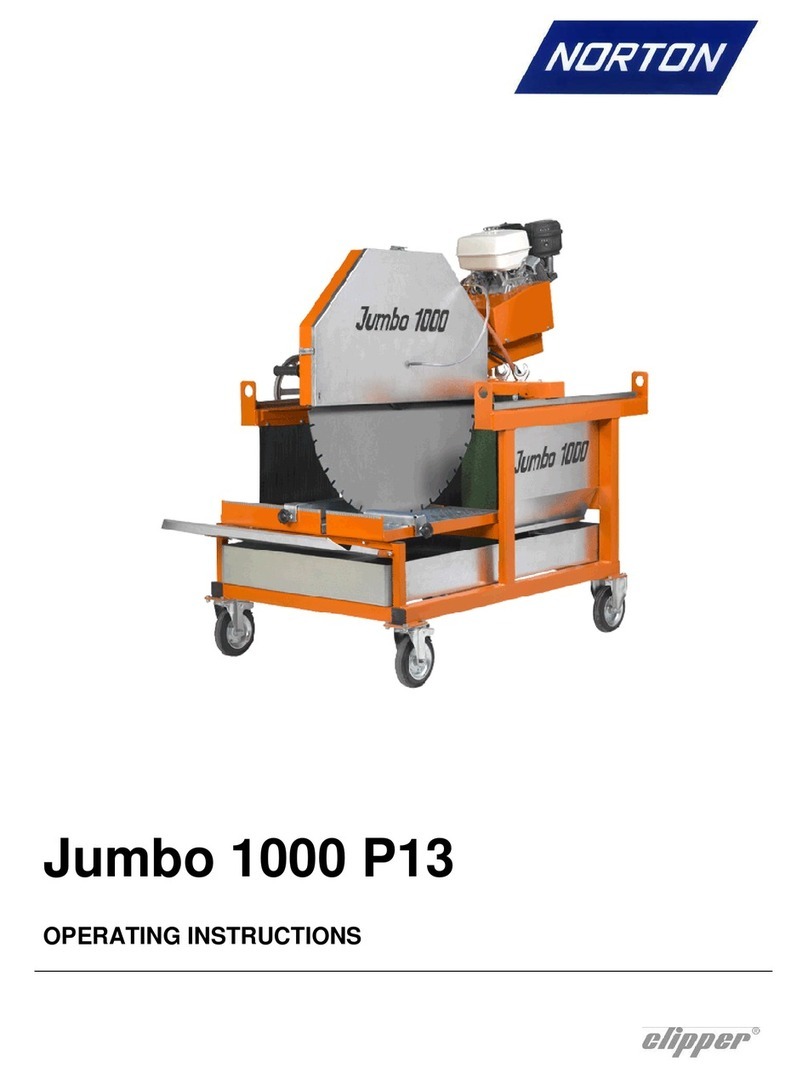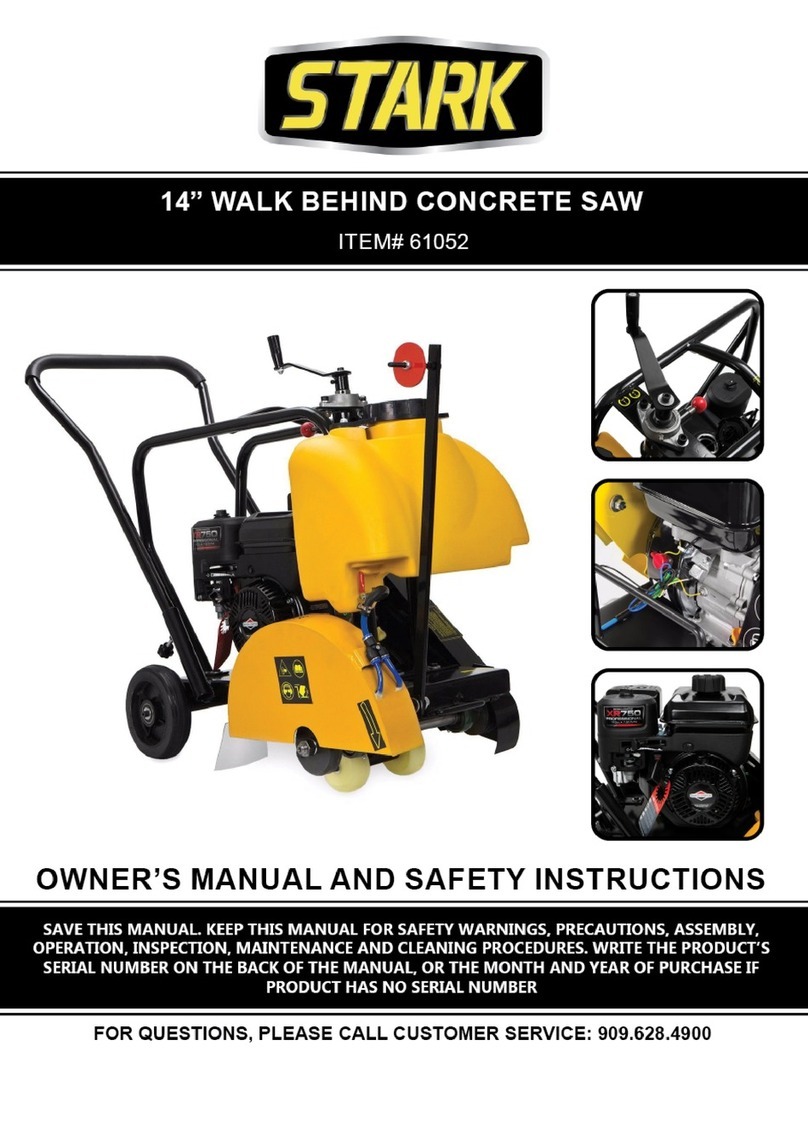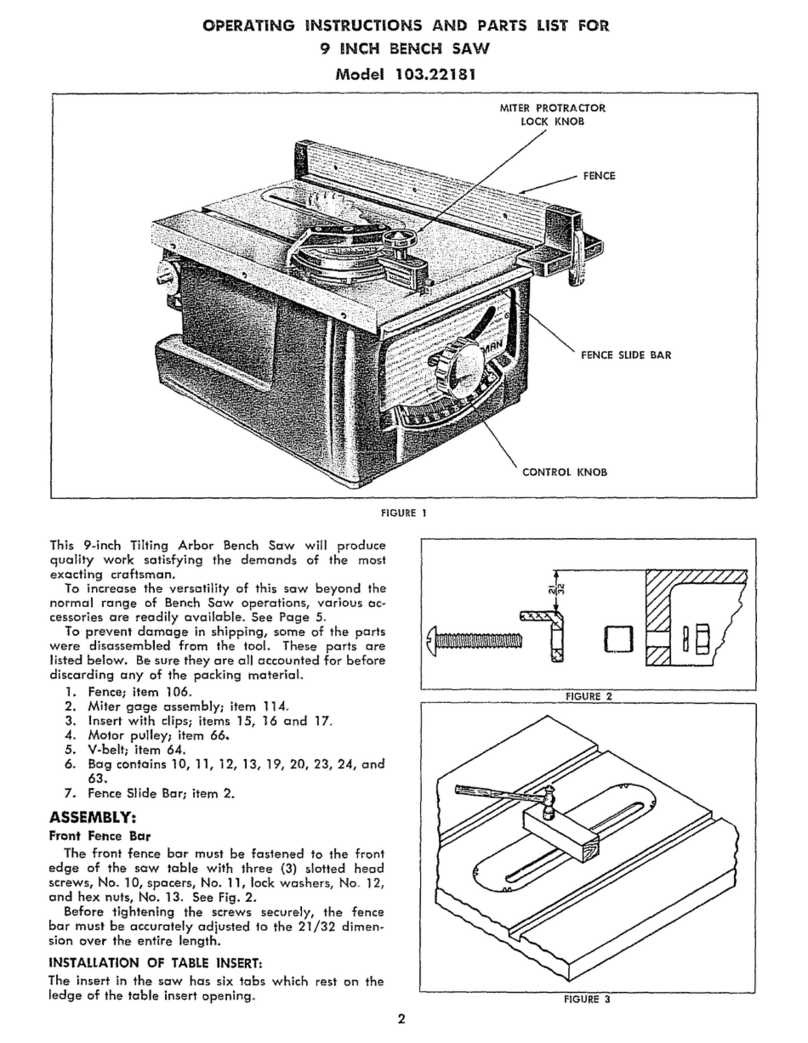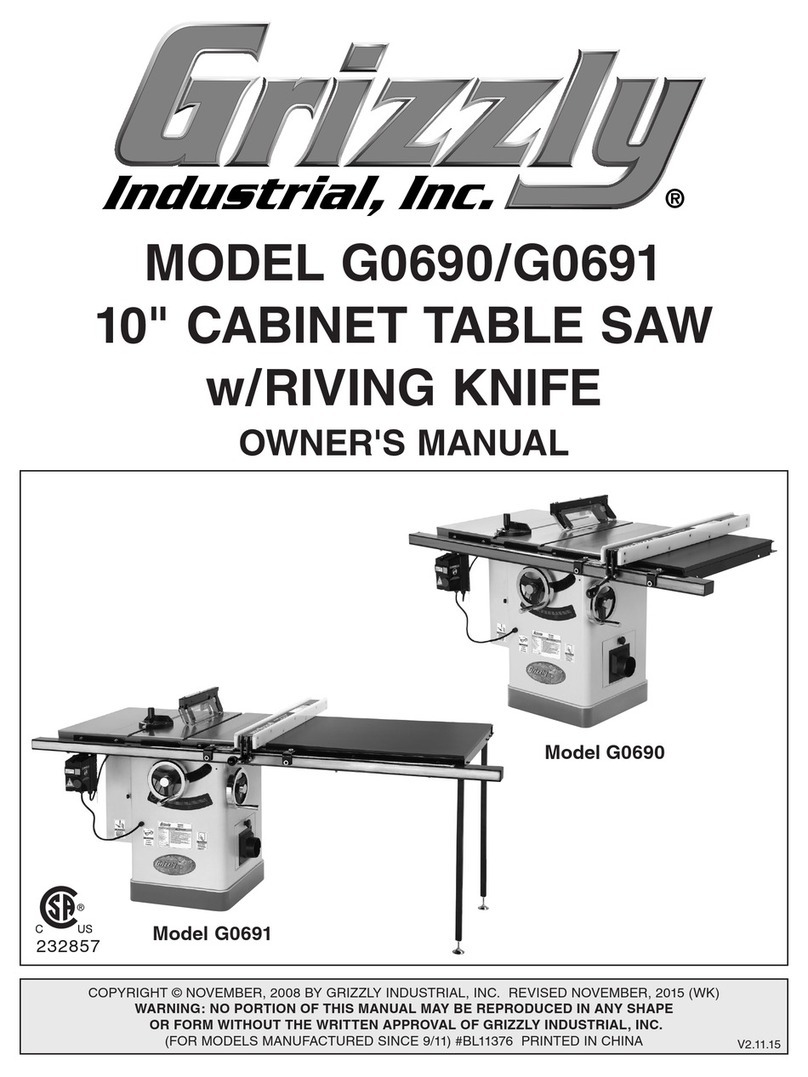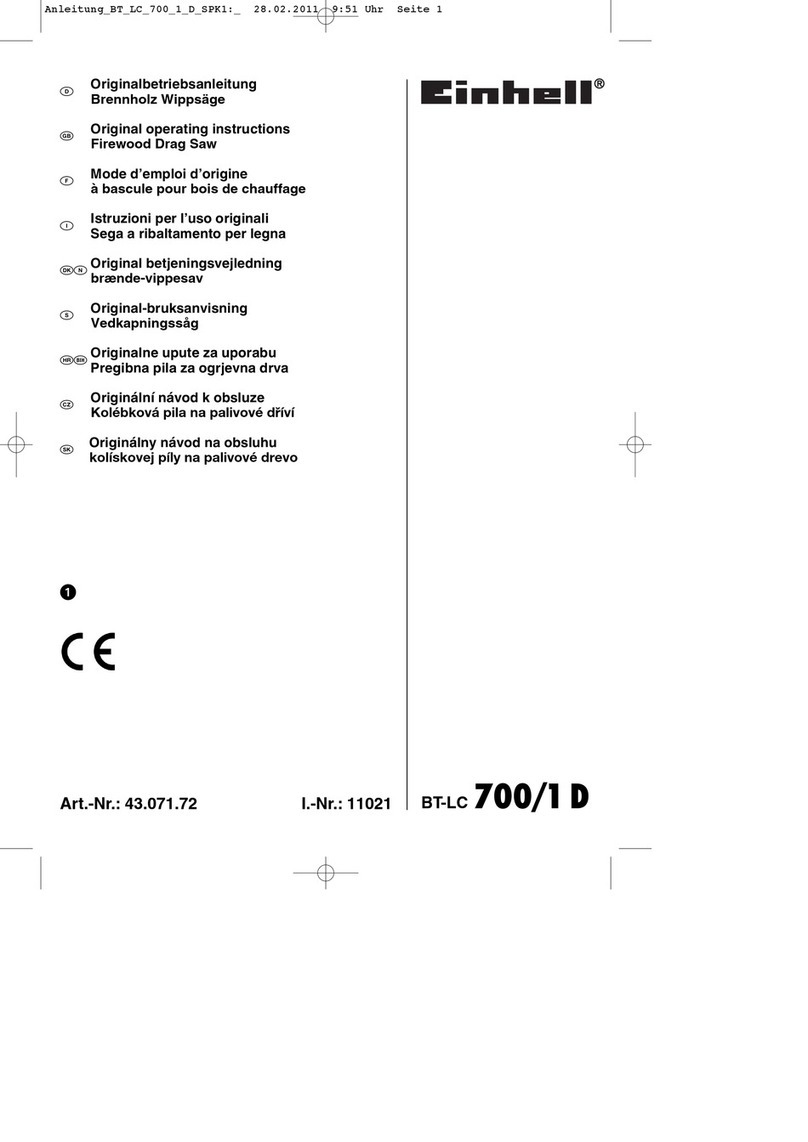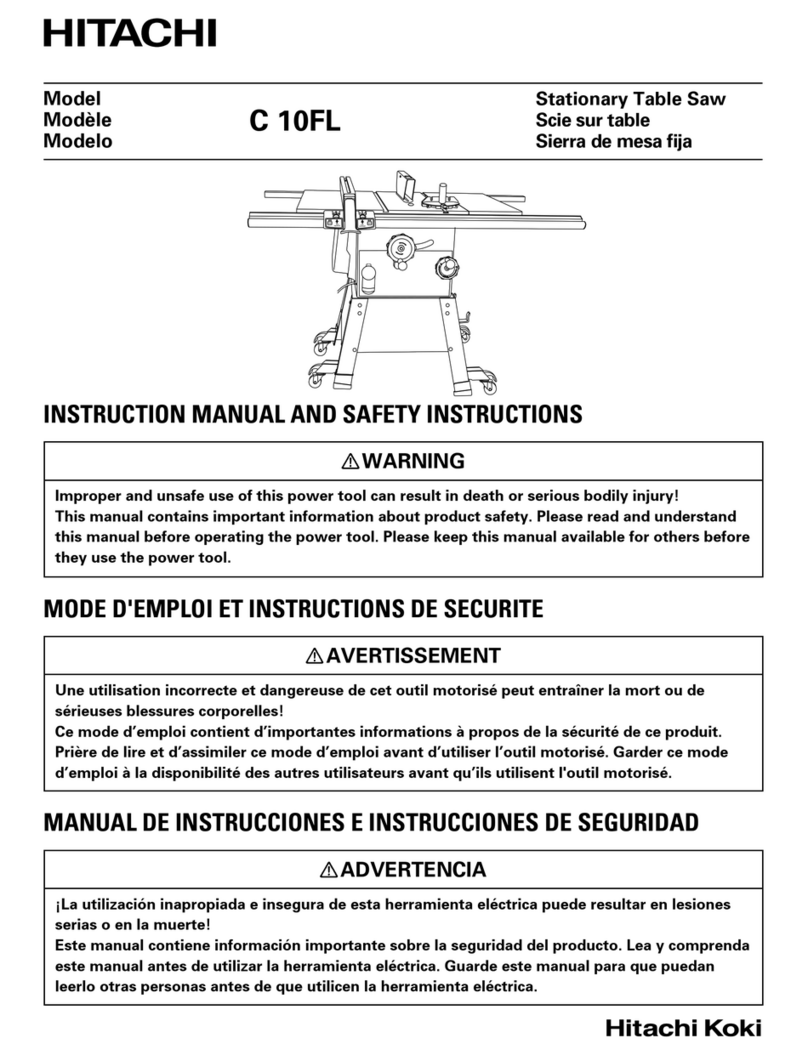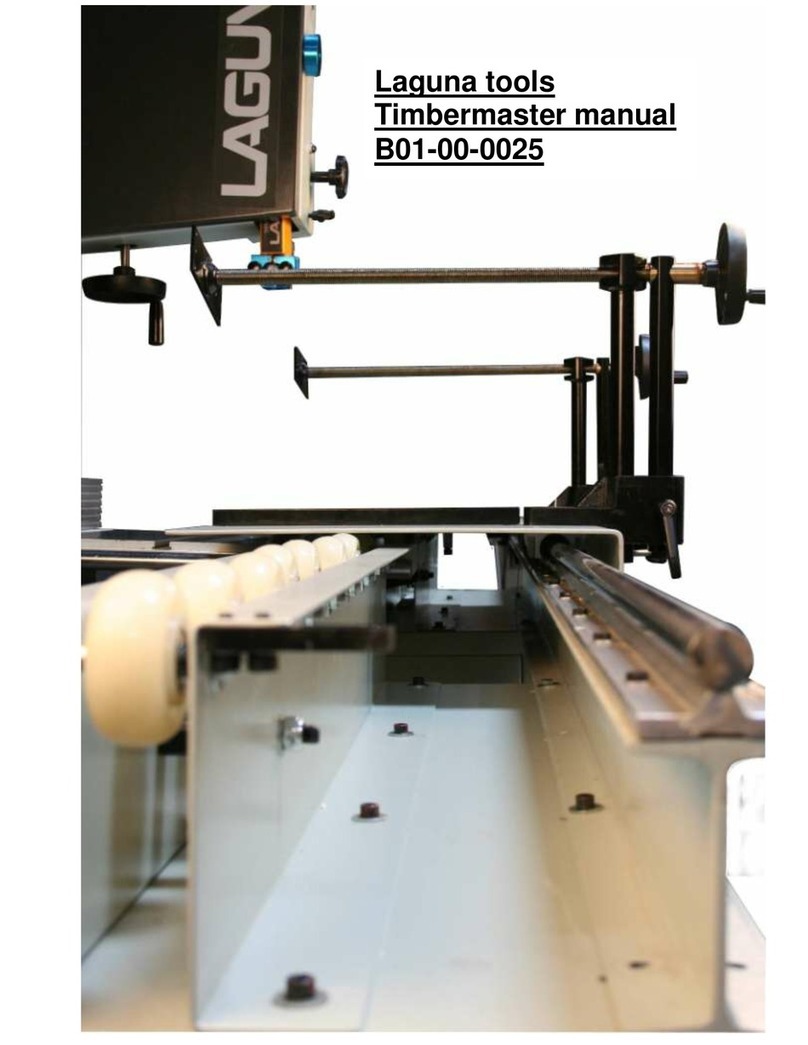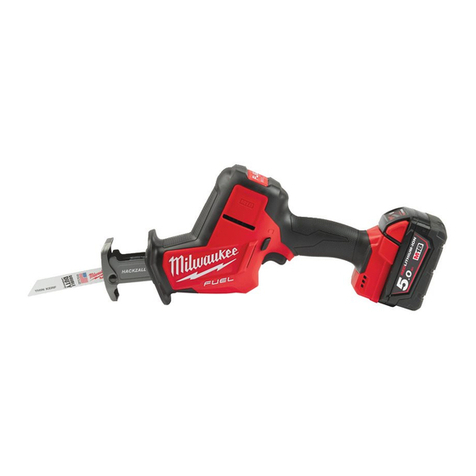Clipper CM 501 HONDA User manual

CM 501 HONDA
OPERATING INSTRUCTIONS
Translation of the original instructions

VERS. 2017.06.21 CM 501 TH_MAN_EN
2

VERS. 2017.06.21 CM 501 TH_MAN_EN
3
The undersigned manufacturer:
SAINT - GOBAIN ABRASIVES S.A.
190, BD J.F. KENNEDY
L- 4930 BASCHARAGE
Declares that this product:
Masonry Saws: CM 501 3.60 P Code: 70184627020
is in conformity with the following Directives:
“MACHINES” 2006/42/CE
“ELECTROMAGNETIC COMPATIBILITY” 2004/108/CE
“NOISE” 2000/14/CE
And European standard:
EN 12418 –Masonry and stone cutting-off machines –Safety
Valid for machines as of serial number:
130400000
Storage site for the technical documents:
Saint-Gobain Abrasives 190, Bd. J. F. Kennedy 4930 BASCHARAGE, LUXEMBOURG
This declaration of conformity loses its validity when the product is converted or modified
without agreement.
Bascharage, Luxembourg, 01.04.2013.
Olivier Plenert, executive officer.
Declaration of conformity

VERS. 2017.06.21 CM 501 TH_MAN_EN
4

VERS. 2017.06.21 CM 501 TH_MAN_EN
5
CM501 HONDA
OPERATING INSTRUCTIONS AND SPARE PARTS LIST
1BASIC SAFETY INSTRUCTIONS 6
1.1 Symbols 6
1.2 Machine plate 7
1.3 Safety instructions for particular operating phases 7
2MACHINE DESCRIPTION 8
2.1 Short description 8
2.2 Purpose of use 8
2.3 Layout 8
2.4 Technical Data 10
2.5 Statement regarding the vibration emission 11
2.6 Statement regarding noise emission 12
3ASSEMBLY AND COMMISSIONING 13
3.1 Tool assembly 13
3.2 Water cooling system 13
3.3 Starting the machine 14
4TRANSPORT AND STORING 15
4.1 Securing for transport 15
4.2 Transport procedure 15
4.3 Long period of inactivity 15
5OPERATING THE MACHINE 16
5.1 Site of work 16
5.2 Cutting methods 16
6MAINTENANCE AND SERVICING 18
6.1 Maintenance of the machine 18
6.2 Maintenance of the engine 18
7FAULTS: CAUSES AND CURES 22
7.1 Fault-finding procedures 22
7.2 Trouble-shooting guide 22
7.3 Customer service 23

VERS. 2017.06.21 CM 501 TH_MAN_EN
6
1 BASIC SAFETY INSTRUCTIONS
The CM501 is exclusively designed for the cutting of construction products mainly on construction
sites.
Uses other than the manufacturer's instructions shall be considered as contravening the regulations.
The manufacturer shall not be held responsible for any resulting damage. Any risk shall be borne
entirely by the user. Observing the operating instructions and compliance with inspection and
servicing requirements shall also be considered as included under use in accordance with the
regulations.
1.1 Symbols
Important warnings and pieces of advice are indicated on the machine using symbols. The following
symbols are used on the machine:
Read operator’s instructions
Ear protection must be worn
Hand protection must be worn
Eye protection shall be worn
Danger: risk of cut
Rotation direction of the blade

VERS. 2017.06.21 CM 501 TH_MAN_EN
7
1.2 Machine plate
Important data can be found on the following plate located on the machine:
1.3 Safety instructions for particular operating phases
Before commencing work
Before commencing work, make yourself familiar with the working environment at the place of
use. The working environment includes: obstacles in the area of work and manoeuvre, the
firmness of the floor, necessary protection at the site relating to public thoroughfares and the
availability of help in the event of accidents.
Check for correct mounting of the blade regularly.
Immediately remove damaged or badly worn blades, as they endanger the operator whilst
rotating.
Only fit NORTON diamond blades to the machine! The use of other tools can damage the
machine!
Attention is drawn to the use of BS2092 safety goggles in conformity with specified Processes
No.8 of the Protection of Eyes Regulation 1974, Regulation 2(2) Part 1.
For security reasons, never leave the machine unattended, untied or unlocked.
While the engine is running
Do not move the machine whilst the blade is running idle.
Always cut with the blade guard in position.
Apply cooling water continuously whilst cutting and in good time!
Petrol powered machines:
Always use the fuel advised.
In confined areas, exhaust gases should be evacuated and the job site properly aerated.
Petrol and diesel machines, which by their nature emit toxic exhaust gases, must not be used in
places prohibited by the Health at Work etc. Act 1974 or which are prohibited by Factory
Inspectors or Safety Officers.
Fuel is flammable. Before filling the tank, shut down the engine, extinguish all open flames and
do not smoke. Take care that no petrol is spilled on any motor part. Always wipe up spilled fuel.
Machine Model
Machine Code
Weight
Year of production
Maximum blade diameter
Machine type
Serial number
Power
Safety standard
Blade speed
Bore
diameter

VERS. 2017.06.21 CM 501 TH_MAN_EN
8
2 MACHINE DESCRIPTION
Any modification, which could lead to a change in the original characteristics of the machine, may
be done only by Saint-Gobain Abrasives who shall confirm that the machine is still in conformity with
the safety regulations.
2.1 Short description
The CM501 block saw is designed for durability and high performance for onsite wet and dry cutting
operations of a wide range of masonry, refractory and natural stone products.
As with all other NORTON products, the operator will immediately appreciate the attention given to
detail and quality of materials used in construction. The machine and its component parts are
assembled to high standards assuring long life and minimum maintenance.
2.2 Purpose of use
The machine is designed for cutting a large range of building and refractory materials. It is not
designed for cutting wood or metals.
2.3 Layout

VERS. 2017.06.21 CM 501 TH_MAN_EN
9
Frame (1)
The jig-welded, reinforced and all-steel construction, diagonally braced to ensure perfect rigidity.
The frame includes a large capacity, sloping water tray with drain plug. Frame has built-in fork lift
brackets (7) for easy transportation. The large base ensures stability while used.
Cutting head (2)
Jig-welded, steel console equipped with pivot bar, which is fixed to frame uprights. Console
supports the electric motor and switch (10), the belt drive with its guard (4), the blade shaft
assembly and the stay level blade guard (3). The balancing of the cutting head is achieved using a
heavy-duty spring. Bearings are machined for perfect fit and alignment.
Blade guard (3)
Jig-welded steel construction with stay level arm and 500mm-diameter blade capacity, which offers
maximum operator protection and increased visibility of the work piece.
Incorporated in the blade guard is a shaft vent cover, which can be easily hinged opened. This
allows easy access to shaft for inspection and blade replacement when motor is switched off, while
fully protecting the blade when in operation.
Down feed and cutting depth adjustment
The spring-loaded cutting head, activated by hand with the grip on the blade guard or with the foot
pedal (5), ensures smooth lowering of the cutting head for shock-free penetration of the work piece
and improved control of the cutting pressure.
A crank assembly (6) in conjunction with a depth locking device on the cutting head pivoting bar
enables the operator to set the cutting head to desired maximum cutting depth.
Conveyor cart (8)
Large, heavy-duty conveyor cart fitted with water flow-control vents, mounted on 4 rollers to give
maximum stability and smooth movement. The conveyor cart is equipped with graduated scale on
the backstop and with a guide-a-cut device.
Water cooling system (9)
The coolant system comprises:
A powerful, submersible mechanical water pump.
Plastic suction pipe delivering the water from the water pan to the cutting head.
A large capacity water pan supplied with drain plug.
A water-tap, fitted to the blade guard, permitting controlled water flow.
Two water nozzles located inside the blade guard ensure adequate flow of water to both sides of
the cutting blade.
A water curtain, fixed to head pivoting bar restricts water spray and minimises water loss.
Petrol Motor (10)
The Honda motor is fitted out with an emergency stop button to ensure the safety of the operator
while using the machine.

VERS. 2017.06.21 CM 501 TH_MAN_EN
10
2.4 Technical Data
Motor
Honda GX200 4.8kW (6.5 HP)
Fuel
Automotive unleaded gasoline
Motor oil
Honda 4-Stroke, or equivalent high detergent, premium
quality motor oil certified to meet or exceed U.S. automobile
manufacturer’s requirement for service classification SG, SF.
(SG, SF designated on the oil container).
SAE 10W-30 recommended
Reduction gear oil
High pressure oil 90
Max. blade diameter
500mm
Bore
25,4mm
Blade shaft speed
2200 min-1
Cutting depth mm
(without reversing the material)
195mm
Flange diameter
108mm
Sound pressure level
(following ISO EN 11201)
93 dB (A)
Sound energy level
(following ISO EN 3744)
106 dB (A)
Cutting length
500mm
Conveyor cart dimensions (Lxl)
580x420mm
Machine Dimensions (LxlxH)
1480x610x1700mm
Weights
Machine
165 kg
Machine ready for work
(with water)
200 kg

VERS. 2017.06.21 CM 501 TH_MAN_EN
11
2.5 Statement regarding the vibration emission
Declared value of vibration emission following EN 12096.
Machine
Model / code
Measured value of vibration
emission at m/s2
Uncertainty K
m/s2
Tool used
Model / code
CM 501 3.60
P
70184627020
<2.5
0.5
Clipper ZDH500
diamond blade
The vibration value is lower and does not exceed 2.5 m/s².
Values determined using the procedure described in the standard EN 12418.
The measurements are made with new machines. Actual values may vary with site conditions, in
terms of:
Materials worked
Wear Machine
Lack of maintenance
Inappropriate tool for application
Tool in poor condition
Unskilled operator
Etc…
The exposure time to vibration is based on the performance of work (related to the adequacy
Machine / Tool / worked material / operator)
When evaluating risks due to hand-arm vibration, you need to take into account effective usage
at rated power of machine during a full day of work; quite often you will realise that effective
utilisation time represents around 50% of overall duration of work. You have to consider, of
course, breaks, water feeding, preparation of work, time to move the machine, disk mounting…

VERS. 2017.06.21 CM 501 TH_MAN_EN
12
2.6 Statement regarding noise emission
Declared value of noise emission following EN ISO 11201 and NF EN ISO 3744.
Machine
Model / code
Sound
Pressure level
LPeq
EN ISO 11201
Uncertainty K
(Sound
Pressure level
LPeq
EN ISO 11201)
Sound power
level
LWeq
NF EN ISO 3744
Uncertainty K
(Sound power level
LWeq
NF EN ISO 3744)
CM 501 3.60
P
70184627020
93 dB(A)
2.5 dB(A)
106 dB(A)
4 dB(A)
Values determined using the procedure described in the standard EN 12418.
The measurements are made with new machines. Actual values may vary with site conditions, in
terms of:
Wear Machine
Lack of maintenance
Inappropriate tool for application
Tool in poor condition
Unskilled operator
Etc…
Measured values relate to an operator in normal use, as described in the manual position.

VERS. 2017.06.21 CM 501 TH_MAN_EN
13
3 ASSEMBLY AND COMMISSIONING
The machine is delivered fully equipped and assembled (although without diamond blade) and is
ready for operation after connection to the appropriate power supply.
3.1 Tool assembly
Only NORTON blades with a maximum diameter of 500 mm can be used with the CM501.
All tools used must be selected with regard to their maximum permitted cutting speed for the
machine’s maximum permitted rotation speed.
Before mounting a new blade into the machine, switch off the machine and isolate it from the main
source of electricity.
To mount a new blade, follow these steps:
Open the shaft vent cover on the blade guard.
Loosen the hexagonal nut on the blade shaft, which holds the removable outer flange.
Remove the outer flange.
Clean the flanges and blade shaft and inspect for wear.
Mount the blade on arbor ensuring that direction of rotation is correct. Wrong direction of rotation
blunts the blade quickly.
Replace outer blade flange.
Tighten hexagonal nut with spanner supplied for this purpose.
Shut the vent cover.
The blade bore must correspond exactly to the diameter of the blade shaft. Cracked or damaged
bore is dangerous for the operator and for the machine.
3.2 Water cooling system
Fill the water pan with clean water to approximately 2cm from top (ensure that bottom of pump is
fully immersed in water).
Open water-tap at blade guard (note that handle on water-tap should be in line with water-flow).
Ensure that water is flowing freely in the circuit and is delivered adequately to both sides of the
blade, as insufficient water supply may result in premature failure of the diamond blade.
The water pump must never run without water. Always make sure that there is enough water in the
pan and refill if necessary.
In case of frost, empty the water cooling system from its water.

VERS. 2017.06.21 CM 501 TH_MAN_EN
14
3.3 Starting the machine
Turn the fuel valve to the ON position.
Move the choke lever to the CLOSED position.
NOTE: do not use the choke if the engine is
warm or the air temperature is high.
Move the throttle control lever slightly to the
left.
Put the engine switch on ON, and make sure
the emergency switch on the board of the
machine is in the correct position.
Pull the starter grip lightly until you feel
resistance, then pull briskly.
CAUTION: Do not allow the starter grip to snap
back against the engine. Return it gently to
prevent damage to the starter.
As the engine warms up, gradually move the
choke lever to the OPEN position.
Position the throttle control lever for the
maximum engine speed.
To stop the engine, move the throttle control lever fully to the right, then turn the engine switch to
the OFF position. Turn the fuel valve to the OFF position.

VERS. 2017.06.21 CM 501 TH_MAN_EN
15
4 TRANSPORT AND STORING
4.1 Securing for transport
Before transporting or lifting the machine, always remove the blade and the conveyor cart and
empty the water pan.
4.2 Transport procedure
If you transport the machine using a fork-lift truck, you have to use EXCLUSIVELY the two fork lift
brackets under the water pan.
4.3 Long period of inactivity
If the machine is not going to be used for a long period, please take the following measures:
Completely clean the machine
Loosen the drive belts
Empty the water system
Take the water pump out of the slurry and clean it thoroughly.
The storage site must be clean, dry and at a constant temperature.

VERS. 2017.06.21 CM 501 TH_MAN_EN
16
5 OPERATING THE MACHINE
5.1 Site of work
5.1.1 Siting the machine
Remove from the site anything, which might hinder the working procedure!
Make sure the site is sufficiently well lit!
Observe manufacturer's conditions for connecting to power supplies!
Make sure you have a continual adequate view of the working area so you can intervene in the
working process at any time!
Keep other staff out of the area, so you can work securely.
5.1.2 Space required for operation and maintenance
Leave 2 m in front of the machine and 1,5 m around it for usage and maintenance of the CM501.
5.2 Cutting methods
To use the machine correctly, you must face it with one hand on the handle of the cutting head, and
the other on the conveyor cart. You can possibly press on the pedal with one foot. Always keep your
hands away from the moving blade.
5.2.1 Full depth or fixed cutting
In full depth or fixed cutting, the cutting head is locked in a fixed position and the material is pushed
into it as shown.
Lower the cutting head to the desired cutting depth (in “through cutting”, lower cutting head until
blade periphery reaches max. 3mm under the surface of the conveyor cart) by means of the
handle on the blade guard or of the foot pedal, or using the crank.
Put material on conveyor cart
Push the conveyor cart slowly and without undue pressure towards the rotating blade and cut
the material as shown on the picture.
NOTE: While recommended, it is not absolutely necessary to lock the cutting head into a given
depth position with the crank when jam cutting. The desired cutting depth can be maintained by
holding firmly the depth feed handle on the blade guard or pressing on the foot pedal. If the full
depth of cut requires excessive pressure (on very dense material e.g.) make 2 or 3 shallow cuts.

VERS. 2017.06.21 CM 501 TH_MAN_EN
17
5.2.2 Multiple step cutting
Multiple step cutting consists of moving the conveyor cart with the material to be cut back and
forward under the rotating blade,
Place the material to be cut on the conveyor cart firmly against the guide-a-cut and the
backstop, keeping the hands well away from the blade.
Move conveyor cart forward near the blade and pull down the cutting head until blade is lowered
to a point where it will lightly contact the surface of the material.
Then pass the material beneath with rapid full length strokes, taking a shallow cut
(approximately 3 mm deep as shown on the picture) on the forward. On the backward stroke, lift
the blade just clear over the cutting line.
Complete each rapid stroke backward and forward by passing the material beyond the centre of
the blade before starting the reverse movement of the conveyor cart.
NOTE: the harder the material, the more rapid should be the forward and backward strokes.
Step cutting lessens the area of the blade circumference in contact with the material, keeping the
blade cool, running free and cutting at peak efficiency.
5.2.3 General advice for the cutting
Make sure you have filled the engine tank with fuel. No petrol is supplied with the machine.
The engine is shipped with oil. Check oil level before starting. Top up if required.
Material weighting under 40 kg and having dimensions smaller than 600x500x390mm (cut with
reversing of the material) can be cut with the machine.
Before commencing work make sure tools are firmly seated!
Select the right tools as recommended by the manufacturer depending on the material to be
worked, the working procedure (dry or wet cut) to be carried out and the required efficiency.
Apply cooling water continuously whilst cutting and in good time! Make sure the water pan
contains enough water.
When dry cutting, ensure sufficient dust extraction and wear a dusk protection mask! You can
also order a dust extraction device (Art. Number 00310004580).
When cutting work is finished, close the water-tap so you can remove the cut pieces from the
conveyor cart without getting wet.

VERS. 2017.06.21 CM 501 TH_MAN_EN
18
6 MAINTENANCE AND SERVICING
6.1 Maintenance of the machine
To ensure a long-term quality from the cutting with the CM501, please follow the maintenance plan
below:
Begin of the day
During the changing of tool
End of the day
or more often if required
Every week
After a fault
After a damage
Whole machine
Visual control (general aspect,
watertightness)
Clean
Flange and blade fixing devices
Clean
Belts tension
Check and adjust
Water pump
Clean
Water pan
Clean
Water hoses and nozzles
Clean
Water pump filter
Clean
Cart guiding bars
Clean
Engine housing
Clean
Reachable nuts and screws
Tighten up
Maintenance of the machine
Your machine will last longer if you clean it thoroughly after each day of work, especially water
pump, water pan, motor and blade flange.
Lubrication
The CM501 uses life-lubricated bearings. Therefore, you don’t need to lubricate the machine at all.
Adjustment and replacement of the belts
To adjust the belts, firstly remove the belt guard by unscrewing the 4 screws. Loose the 4 motor
bolts and shift the motor by using the two screws on the side.
To replace the belts, move the motor forward on the cutting head. Adjust the belts and retighten
them by shifting the motor to the rear of the machine.
Always use a matched set of belts. Do not replace single belts.
6.2 Maintenance of the engine

VERS. 2017.06.21 CM 501 TH_MAN_EN
19
Regular service period
Perform at every indicated month or
operating hour interval, whichever comes
first
Each use
First month or 20 hours
Every 3 months or 50 hours
Every 6 months or 100 hours
Engine oil
Check level
Change
Reduction gear oil
Check level
Change
Air cleaner filter
Check
Clean
Fuel strainer cup
Clean
Spark plug
Check-Clean
Fuel line
Check (Replace if necessary)
Every 2 years
Engine oil
To change the oil,
Remove the oil filler cap/dipstick and
drain bolt.
Allow the oil to drain completely.
Reinstall the drain bolt, and tighten it
to 18 N.m.
Fill the crankcase with the engine oil to
the outer edge of the oil filler neck.
Reinstall the filler cap/dipstick.
Reduction gear oil
Remove the oil filler cap and wipe the
dipstick clean.
Insert the dipstick into the filler neck, but
do not screw it in.
If the level is low, fill to the upper level
mark.

VERS. 2017.06.21 CM 501 TH_MAN_EN
20
Air cleaner
The CM501 has a dual type filter.
To service the air cleaner filter, follow
these instructions:
Remove the nut, air cleaner cover and
wing nut.
Remove the pre air cleaner elements
and separate them.
Carefully check both elements for
holes or tears and replace if damaged.
Paper element: tap element lightly
several times on a hard surface to
remove excess dirt or blow
compressed air lightly through the filter
from the inside out. Never brush the
dirt off; brushing will force dirt into the
fibres.
Foam element: clean in warm soapy
water, rinse and allow to dry
thoroughly. Dip the element in clean
engine oil and squeeze out all the
excess. The engine will smoke during
initial start-up if too much oil is left in
the foam.
Shine a light through the elements,
and inspect them carefully. Reinstall
the elements if they are free of holes
and tears.
Fuel strainer cup
To service fuel strainer cup, follow these
instructions:
Turn off the fuel valve and remove the
strainer cup.
Clean the strainer cup with solvent.
Install the O-ring and strainer cup.
Tighten the strainer cup to 4N.m.
Table of contents
Other Clipper Saw manuals
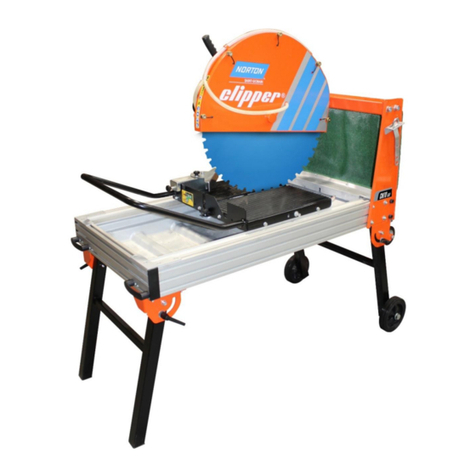
Clipper
Clipper CM70 ALU User manual
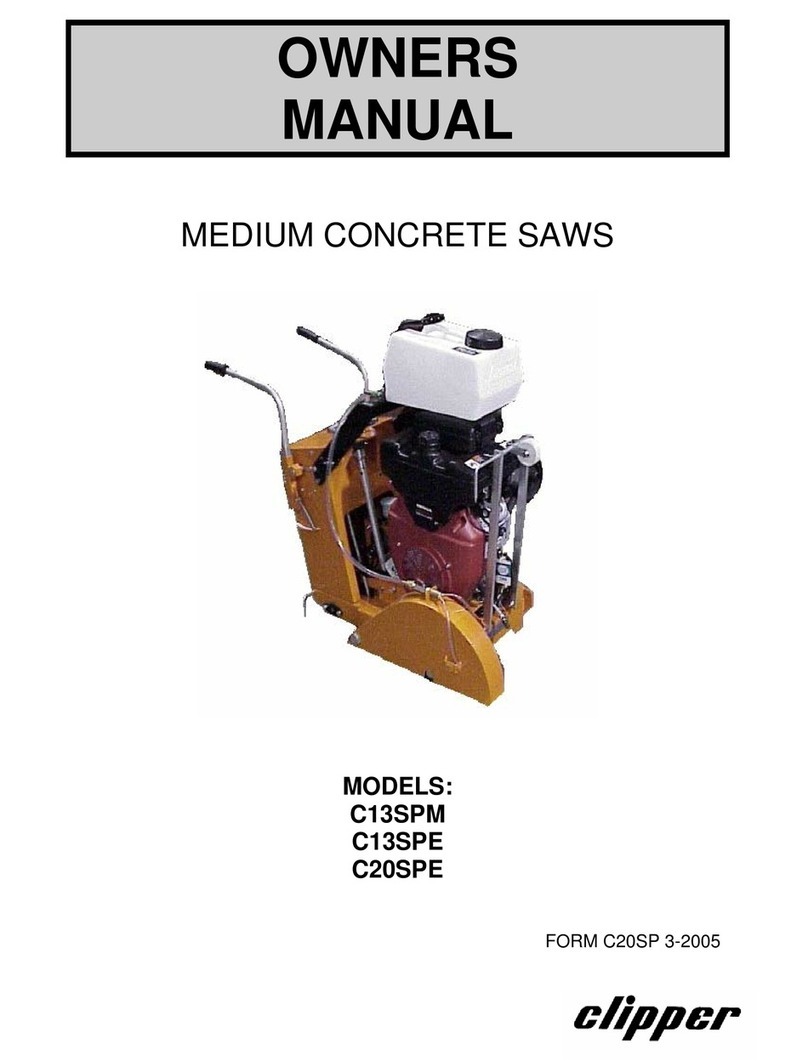
Clipper
Clipper C13SPM User manual
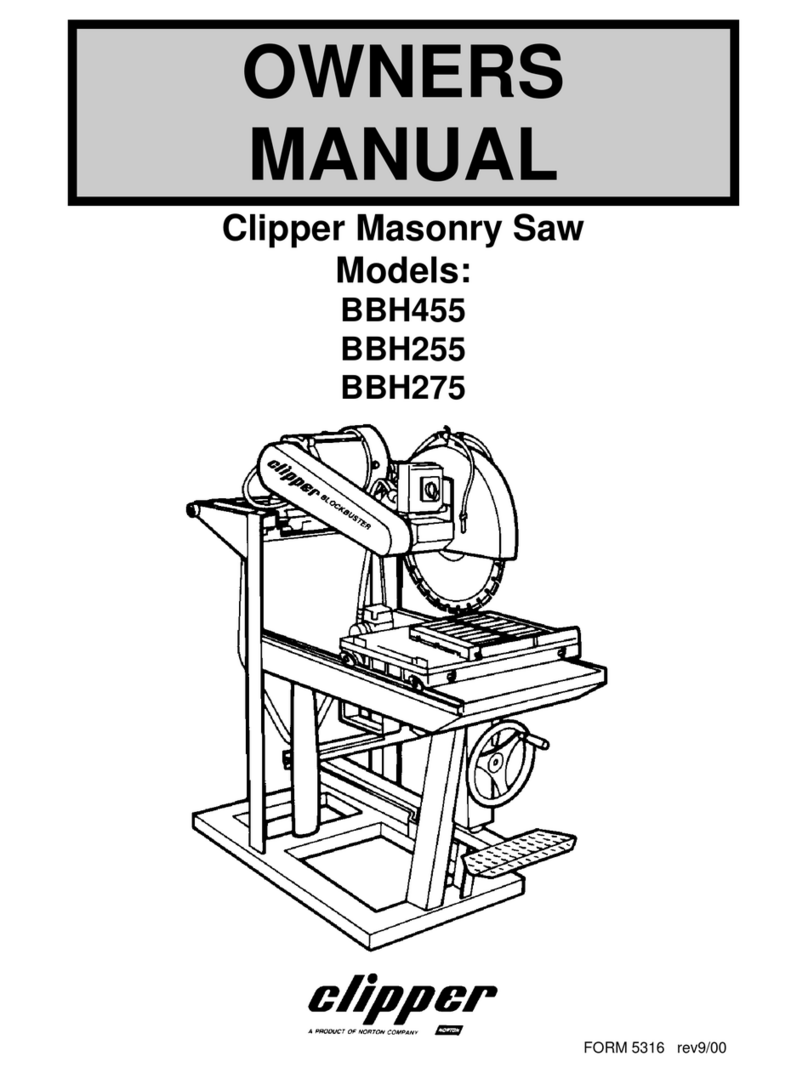
Clipper
Clipper BBH455 User manual
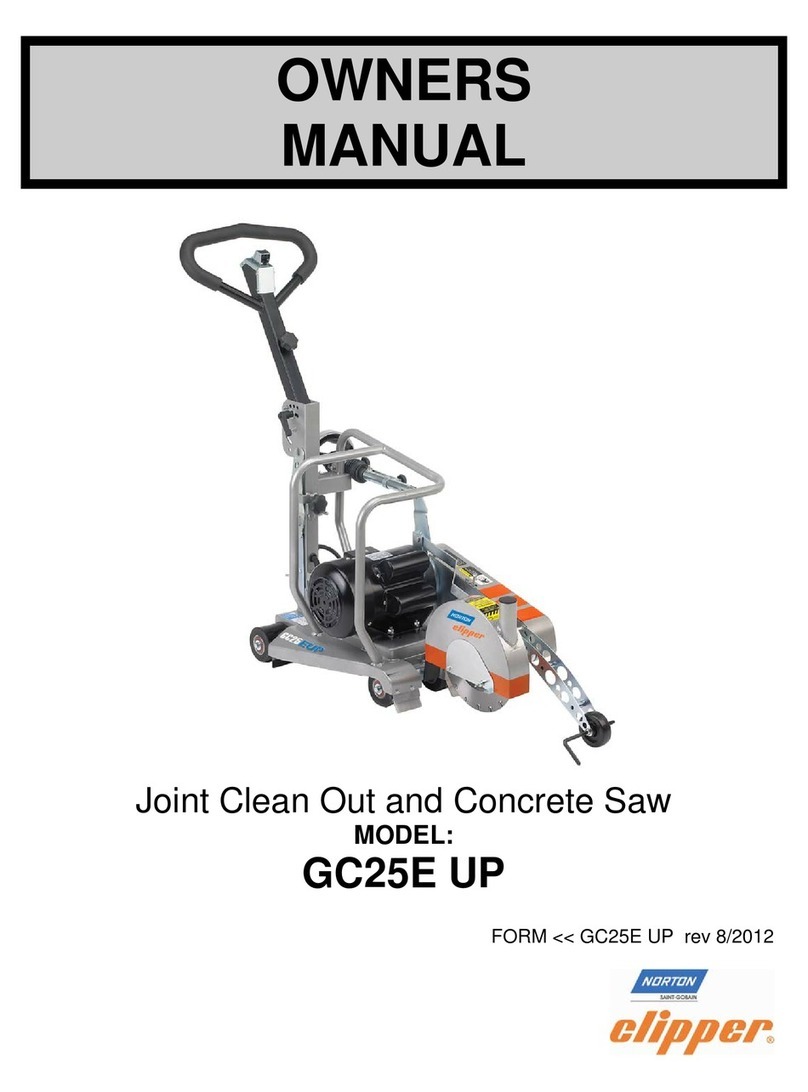
Clipper
Clipper GC25E UP User manual

Clipper
Clipper BBC157 User manual
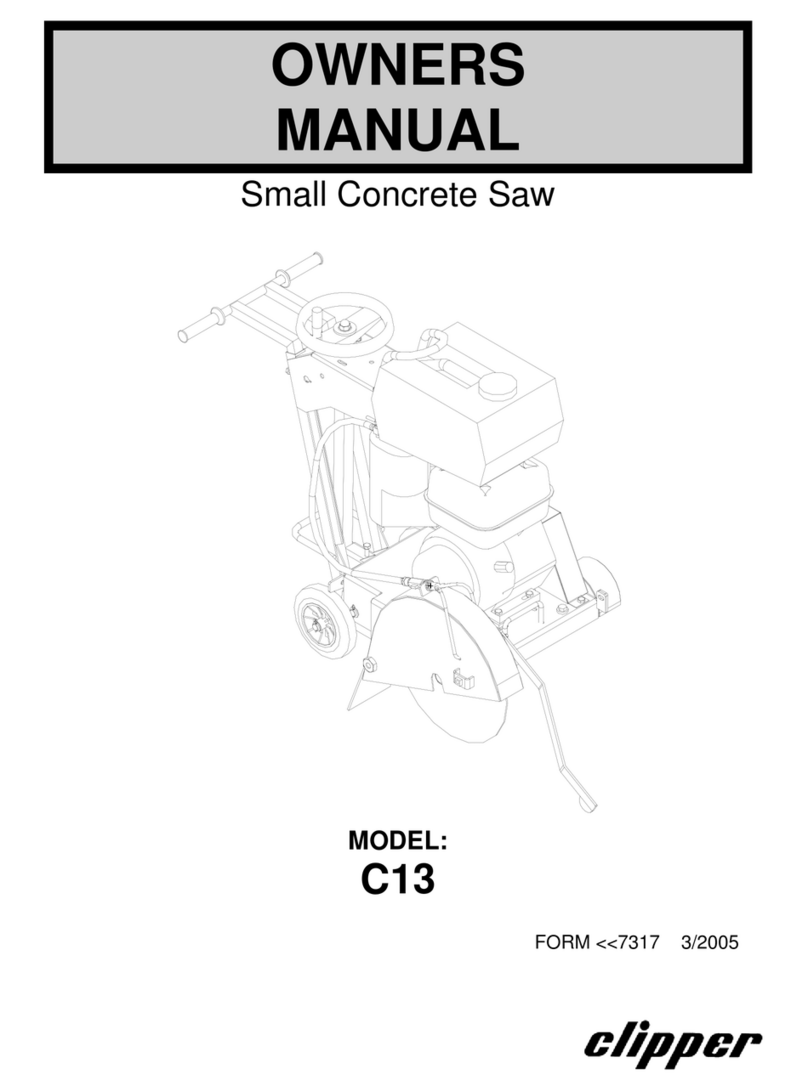
Clipper
Clipper C13 User manual
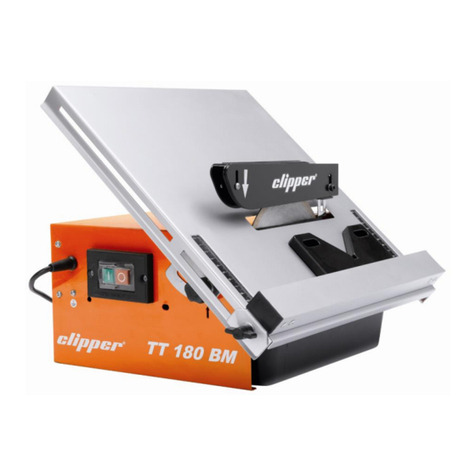
Clipper
Clipper TT 180 BM User manual
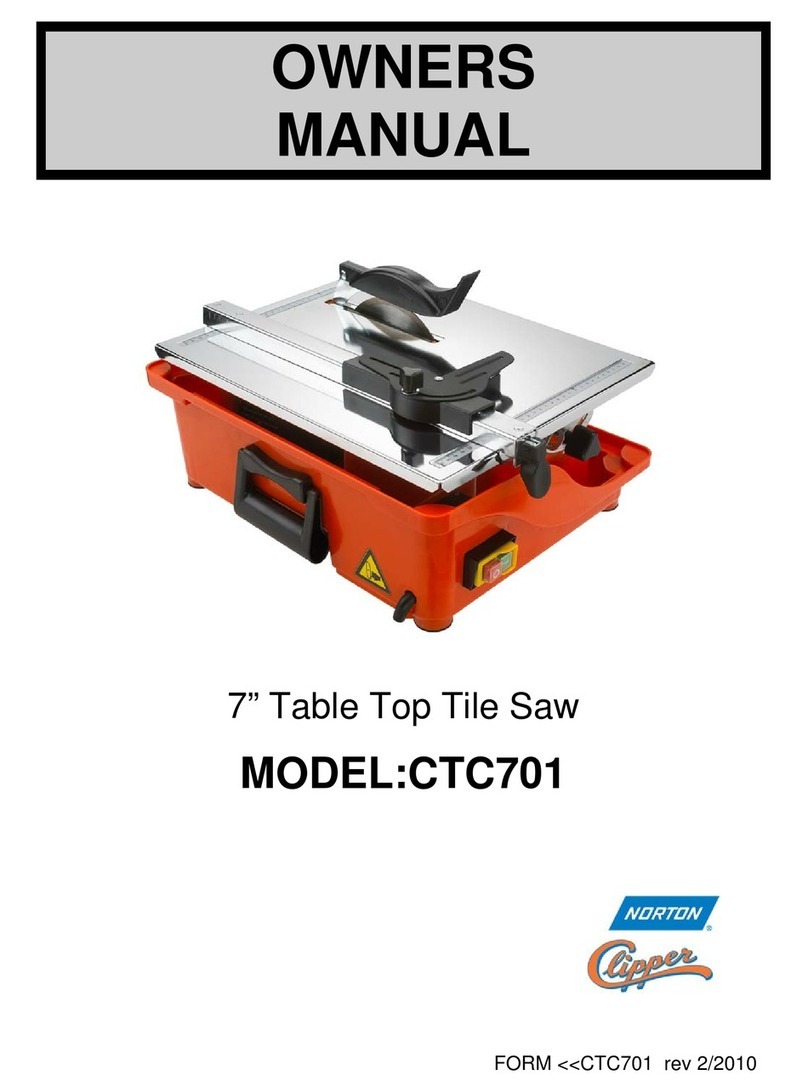
Clipper
Clipper CTC701 User manual
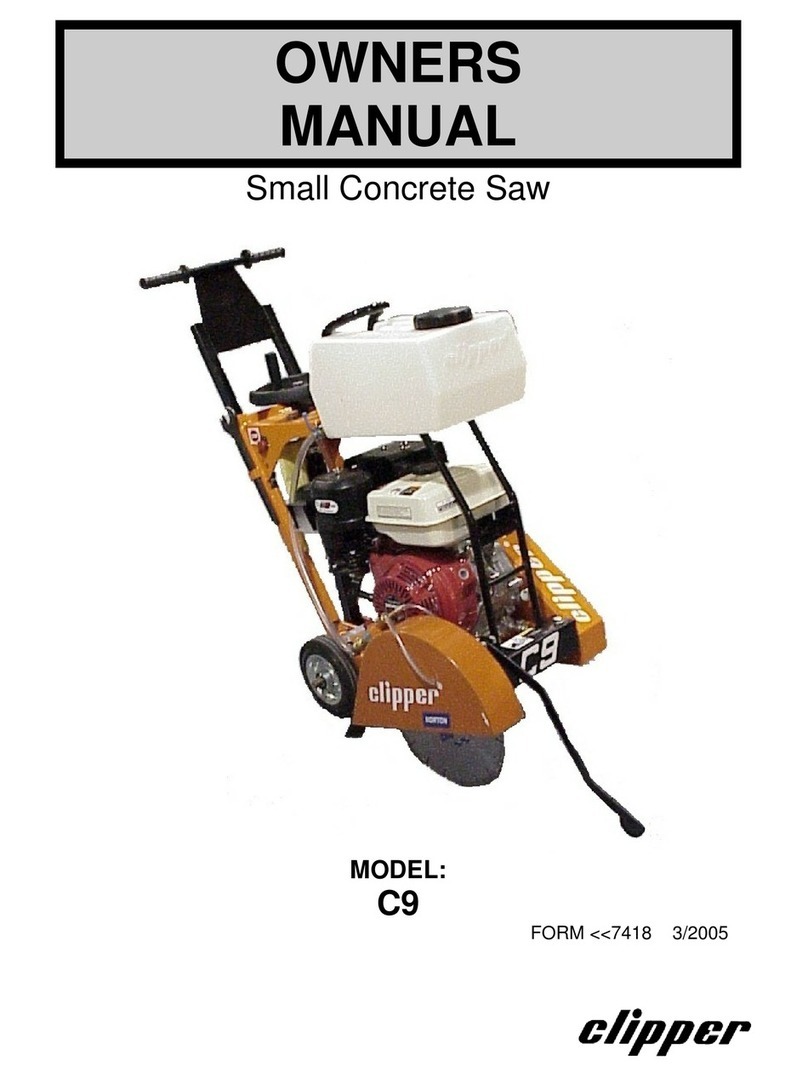
Clipper
Clipper C9 User manual
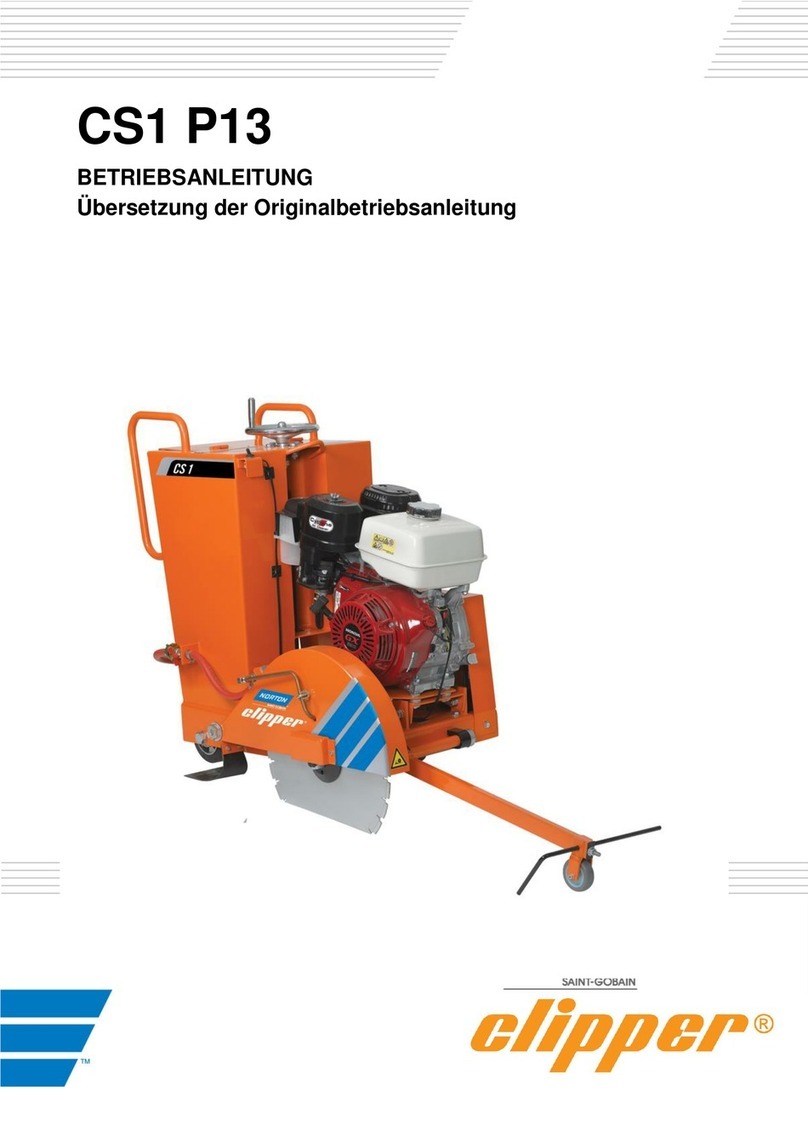
Clipper
Clipper NORTON CS1 P13 User manual

